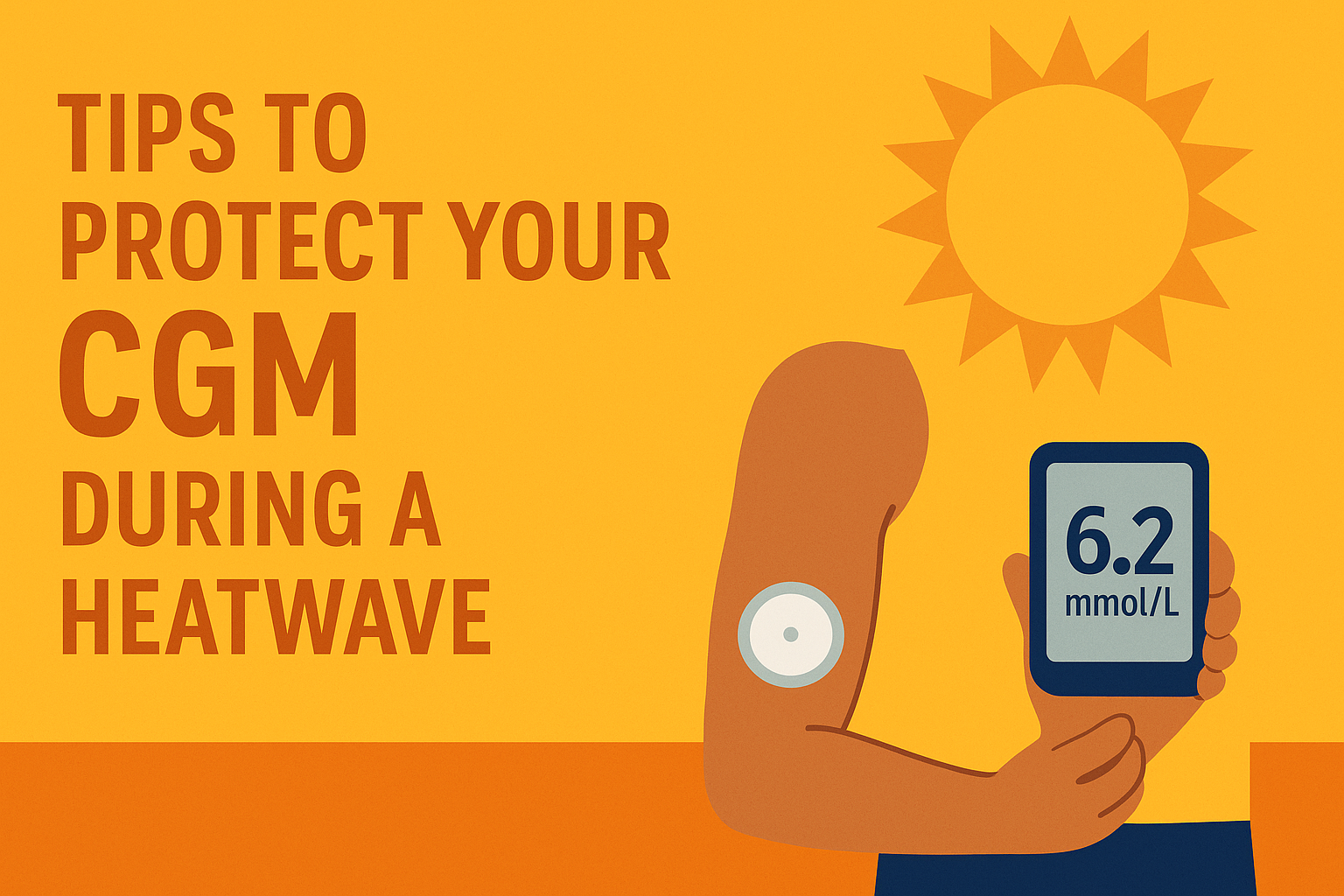Scan results are often compared to finger prick levels and if they’re different, users assume that the Libre isn’t ‘accurate’. This blog considers five actions that sensor wearers can take to improve the ‘accuracy’ of the readings gained from a Libre sensor, meaning that the readings will be closer to finger-prick tests.
- Choose an appropriate time to apply the sensor when levels are stable
- Keep your body hydrated
- Get moving
- Improve the quality of your sleep
- Avoid stressful situations.
There’s more about each of these actions below.
Choose an appropriate time to apply the sensor when levels are stable

When using a Libre sensor not many of us give any thought to the time of application and will often apply a new sensor as soon as the old one ends, or some other incident occurs which ends the use of that sensor. But this could mean that perceived accuracy is thwarted at the outset, as users fail to give consideration to what their glucose is doing at the time.
It’s logical that glucose readings obtained from scans are most consistent when levels are stable i.e. when the trend arrow is horizontal. This is generally when in a fasting state or before a meal – when there isn’t any, or relatively low levels of active insulin onboard. Applying your sensor at this time will mean that it doesn’t need to adjust to fluctuating levels and readings over the 14-day period are more likely to compare well with finger-prick tests.
TIP:
Try to avoid applying your sensor when glucose levels are changing rapidly, for example immediately after eating, especially if the trend arrow is pointing directly up or down. Sometimes this may mean waiting for a suitable time, rather than wearing a sensor 24/7 back-to-back.
Keep your body hydrated

Throughout the day, we are continually losing water and typically this will be the equivalent of 2 to 3 glasses of water when breathing, 7 or 8 glasses through urination and another full glass as sweat whilst moving and doing our daily activities. This loss is a crucial process to removing toxins from the body and further loss of water can occur when undertaking vigorous exercise, or when the body is fighting illness or infection.
Drinking water to maintain our levels of hydration is key to our health but the amount of water we need will vary from person to person and from one day to the next. As a general rule, it’s recommended that we drink 1 or 2 glasses of water per hour during a typical working day.
Keeping our fluid intake up means that our body (and as such, our skin) will function better. Even mild dehydration can impair our bodily functions from working efficiently and this can have another consequence too. For example, dry skin can cause our sensor to loosen and/or fall off.
Ensuring we stay hydrated will help to keep glucose levels more stable which gives us better quality scan readings and over time will improve our general health and lead to more time in range and a lower HbA1c.
TIP:
Use the following Hydration Equation to calculate the amount of water you need on a daily basis:
Weight (in kg) Divide by 30 = Quantity of water (in litres) to drink daily
For those persons more active, it’s recommended to drink more.
Get moving
 It’s a simple, often quoted statement that the more we move, the more efficiently our bodies will work. And this applies to the take-up of insulin in our blood where insulin sensitivity is increased by exercise.Insulin sensitivity refers to how responsive the body’s cells are to insulin and high insulin sensitivity allows cells to use glucose more effectively, reducing glucose levels. Insulin sensitivity varies between people.
It’s a simple, often quoted statement that the more we move, the more efficiently our bodies will work. And this applies to the take-up of insulin in our blood where insulin sensitivity is increased by exercise.Insulin sensitivity refers to how responsive the body’s cells are to insulin and high insulin sensitivity allows cells to use glucose more effectively, reducing glucose levels. Insulin sensitivity varies between people.
Regular exercise will help to decrease the amount of insulin needed and improve your glucose levels, so help you to increase time in target i.e. stay in your zone! It doesn’t have to mean going to a gym, if that’s not your thing. Just moving in other ways can make a difference!
Exercise increases insulin sensitivity not only during the actual physical activity but also in the time following that activity so you may need less insulin in the hours after your workout as the insulin works more efficiently in your body.
TIPS:
You can use the data from scanning your Libre to look for trends and understand how your levels change with different types of movement or exercise, then make adjustments as appropriate.
And remember, it’s about movement not just ‘exercise’ so make it your aim to move more in general and avoid long periods of inactivity.
Improve the quality of your sleep

It’s no secret that getting a good night’s sleep is a key factor to our health and wellbeing. And the contradictory is also true in that a lack of sleep or poor-quality sleep can affect us physically, mentally and emotionally. For those with diabetes, getting less sleep than we need can negatively affect our insulin sensitivity quite markedly, making us more insulin resistant.
The knock-on effect is that we need to ‘correct’ our levels and inject more, more often. We are more likely to experience spikes in our glucose levels, riding the highs and lows of the diabetes rollercoaster. However, improving our sleep can directly affect those levels and our time in range.
It’s widely known and accepted that adults need between 7 and 9 hours of sleep per night, but many of us are not getting this, either through our own choice or through having a sleep disorder. Recent scientific studies have looked at the relationship between insulin resistance and sleep deprivation and have shown that poor sleep negatively affects how insulin is used by the body, and in particular, having enough deep sleep seems to be linked with regulating the amount of glucose in the blood.
There are 5 stages of sleep that we go through on a cycle that repeats several times through the night. Deep sleep is stages 3 and 4, preceding REM rapid eye movement sleep. REM sleep occurs around 90 minutes after you fall asleep and it is during this stage of sleep that the body uses the least amount of glucose.
Relatively recently it’s been established that too much light exposure before bedtime ie. blue light from screen use, is affecting the quality of our sleep and even a single night of light exposure during sleep can acutely impact insulin resistance may have long-term effects on metabolic function. It therefore follows that we should take up healthy sleep habits and most crucially give ourselves enough time to sleep.
TIPS:
Sleep trackers as wearable tech or part of a ‘fitness watch’ are becoming a popular option and this can help you to pinpoint your sleeping patterns. These track your body’s movements during the night and by analysing this information you can see how much time in each sleep stage your body needs for a good night’s sleep.
A less-tech solution is to induce sleep through the use of heat, for example, taking a hot bath before bed may help improve the quality of sleep. Eating a low-carbohydrate diet is also thought to promote deep sleep.
Avoid stressful situations

Let’s face it, for most of us, dealing with our diabetes every single day can be stressful enough, aside from dealing with all the other stresses in our life. The management of diabetes can mean that we’re in a never-ending spiral of stress! There are days when applying logic to our diabetes apparently has no effect, and glucose levels just don’t make sense.
But for those of us who have the Libre sensor, now have more data with which to work out what our body and specifically our glucose levels are doing. This can help us to predict and foresee stressful situations and sometimes to take appropriate preventative action.
When the body is struggling with stress, it releases the stress hormones cortisol and adrenaline which is known as the ‘flight or fight’ response. These hormones prevent insulin from working and this raises the concentration of glucose in the blood and our levels rise as the body resists insulin. There is also some evidence that mental stress can elevate glucose levels.
Stress hormones can occur at any stage of our lives and unfortunately, nobody reacts the same way to the different types and strains of hormones. We need to pay attention to our own glucose levels, made easier to do so with a Libre sensor, and adjust our insulin requirements as appropriate.
This may seem obvious and is usually something that is easier said than done, but ensuring we make time for rest and relaxation will help us to cope better with stress and reduce the number and severity of spikes we see on our Libre graphs. Again, this will lead to better ‘accuracy’ in Libre scans with numbers we can rely on.
TIPS:
It is too easy to get caught up with focussing on individual numbers as if we’re attempting to pass a test. Whilst more data is helpful, the real benefit of using a Libre sensor is to use it for understanding trends and patterns in our diabetes management. To avoid the stress of more data, resist the temptation to scan your sensor too much – perhaps limit your scans to once every hour with the aim on keeping in your zone.
To learn more about our OWN YOUR ZONE alternative approach to diabetes management, please click here to see our blog.
______________________
Disclaimer:
Love My Libre is not associated or affiliated with Abbott or FreeStyle Libre. Content here and on our website www.lovemylibre.com does not constitute medical advice or replace the relationship between you and healthcare professionals nor the advice you receive from them.
The author of this blog has type 1 diabetes and uses the FreeStyle Libre 2 which is provided on NHS prescription.
FreeStyle Libre is a registered trademark of Abbott Diabetes Care Inc.




Mike Dacosta
April 20, 2021
Hi team,
I was recommended to fit the next sensor on a couple of days before change over day,
that way it give the new site area, time to settle down,
I find I do get more acurate readings from this method.